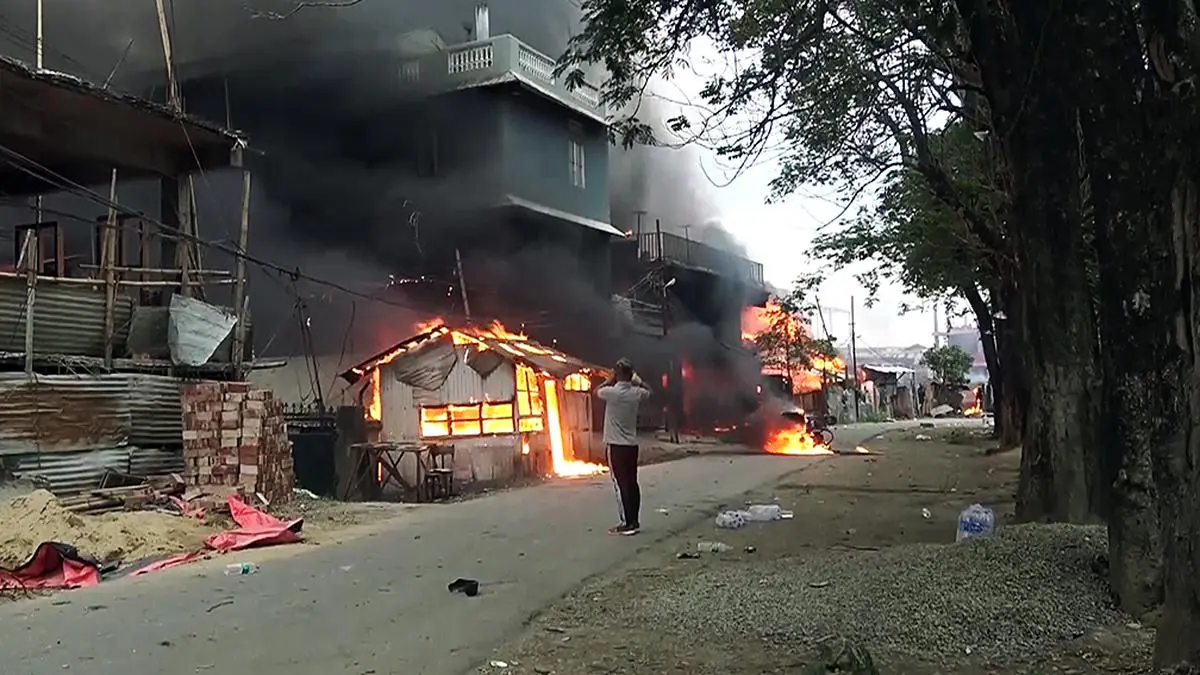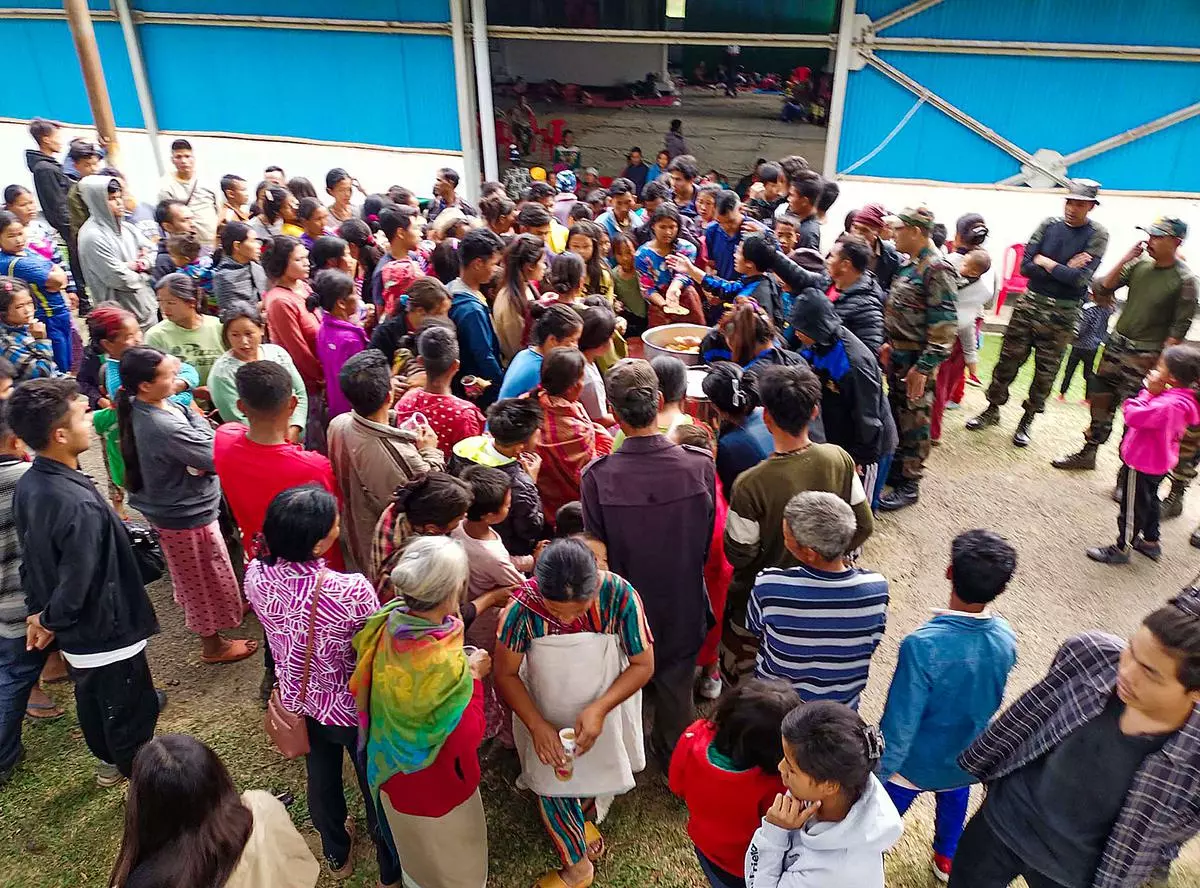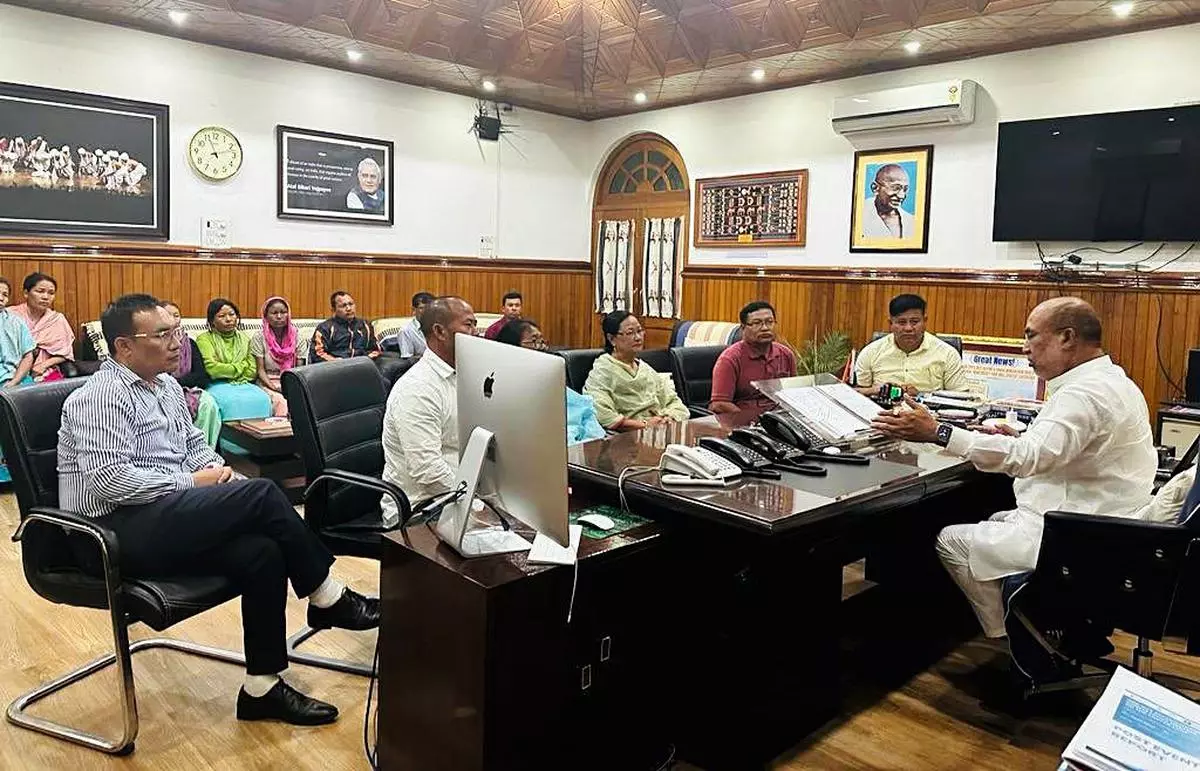Months of violence in Manipur have drawn attention to the underlying issues fueling the unrest. While the immediate cause is the demand for Scheduled Tribe (ST) status for the Meiteis, it is not the only factor that has plunged the peace-loving state into violence and has remained a mere spectator. So let us in this article what are the other real reasons that fueled the violence in Manipur. Must read the article till the end.
 |
| Image Credit-https://frontline.thehindu.com |
Violence in Manipur
ST Status Requirement:
The violence erupted after the All Tribal Students' Union Manipur (ATSUM) organized a solidarity march protesting the Manipur High Court's order recommending the inclusion of the Meitei community in the ST (Scheduled Tribe) list. This demand has been a significant point of contention and a catalyst for recent unrest.
Official Solution:
The Manipur government's response to the violence empowered district magistrates to issue shoot-at-sight orders to rioters. Such measures were considered adequate and raised concerns among citizens about human rights violations in the region.
Invocation of Article 355:
As violence escalated, the central government invoked Article 355 of the Constitution, giving it the power to protect a state from external aggression or internal disturbance. This led to the deployment of military, paramilitary, and police forces in the affected areas, further exacerbating the situation.
Casualties and Displacements:
The violent clashes have resulted in many casualties, with reports of over a dozen dead and hundreds injured. Additionally, approximately 9,000 persons have been displaced, including members of the Kuki and Meitei communities, who are seeking shelter and protection from the conflict. There has been extensive damage to buildings, houses, vehicles, and other properties. Continued violence and arson have forced people to relocate.
Rising tension and widespread violence in Manipur
Rising tensions in Manipur have led to an increase in violence and lawlessness, with authorities struggling to regain control. Mobile data and broadband connections have been suspended, leading to communication disruption. As the situation worsens, many individuals and communities have been forced to flee for their safety. Chief Minister N. Despite attempts by Biren Singh to restore peace, retaliatory attacks and vandalism of properties further escalated the unrest.
Displaced Community:
As the violence intensified, around 5,000 people have been shifted to safe houses or shelters in Churachandpur, while another 2,000 sought shelter in the Imphal Valley. An additional 2,000 persons have been shifted to the border town of Moreh in the Tengnoupal district. These displacements reflect the dire circumstances faced by the affected communities.
Targeted Attacks:
Reports indicate that an armed mob specifically targeted members of the Meitei community during a road march on 3 May in the Torbung area of Churachandpur district. In response, counter-attacks broke out in the districts of the valley, resulting in vandalism and destruction of shops and houses in Torbung. ,
Chief Minister's argument ineffective:
Chief Minister N. The situation remains volatile despite Biren Singh's appeal for calm and assurance of government measures to maintain law and order. The government has requisitioned additional paramilitary forces and directed the security forces to take strict action against those involved in the violence. However, these efforts have so far proved futile in establishing peace.
Imposing curfew:
In an attempt to restore order, an indefinite curfew has been imposed in several districts. Meitei-dominated districts of Imphal West, Kakching, Thoubal, Jiribam, and Bishnupur, as well as Kuki-dominated Kangpokpi and Tengnoupal districts, are under curfew. Over 500 Kuki community members have sought shelter in the CRPF camp at Lamphelpat in Imphal, while Meitei residents have fled the Churachandpur district due to the violence.
Spreading Violence:
Incidents of violence have spread beyond specific areas to the border town of Moreh in the Tengnoupal district. Meitei homes were targeted and set on fire, worsening an already tense situation. Violent incidents were also reported from different parts of the capital Imphal.
Know the root causes of the conflict in Manipur
The caste unrest and violence in Manipur stemming from the demand for the inclusion of the Meitei community (53% of Manipur's total population) in the Scheduled Tribe (ST) list has its roots in deep grievances. These include government action regarding reserve forests in hilly areas, alleged oppression of the Kuki community, and land disputes. These underlying factors have fueled anger and contributed to the current conflict.
Forest Encroachment and Harassment:
Relations with tribal communities have been strained by the government's crackdown on reserve and protected forests in the hilly areas of Manipur due to concerns over its handling of poppy cultivation and drug-related issues. However, the government's widespread labeling of "drug lords" has unjustly implicated the entire Kuki community, leading to feelings of victimization. Additionally, the influx of Chin people from Myanmar, who share ethnic ties with the Kuki, has further increased tensions due to the government's crackdown on alleged illegal immigration.
Land pressure and inequalities:
Competition for land in Manipur has intensified as population growth has led to tribal villages expanding into adjacent forest areas, which are seen as their historical and ancestral rights. However, the government contests these claims, leading to a controversy. Meanwhile, Meitei communities living in the valleys are frustrated by restrictions on their ability to settle or buy land in hilly areas, while tribal communities enjoy the privilege of buying land in the valleys. These inequalities fuel feelings of injustice and resentment.
Lack of clear policies:
The lack of a comprehensive policy to recognize new villages and a transparent forest policy in Manipur have added to the grievances. The government's ambiguity and lack of transparency in addressing these issues have caused resentment, even within its own political party.
BJP MLA's Protest against forest survey and Defiance of state government: sowing seeds of Conflict in Manipur
The conflict in Manipur revolves around protests led by BJP MLA Paolinlal Haokip against the revenue and forest surveys carried out in the Churachandpur-Khaupum Reserved Forest. The Haokip and Aboriginal communities express concern about perceived injustices and violations of their rights. However, the state government, led by Chief Minister Biren Singh, has remained steadfast in its support for the expansion of reserve forests, citing the need to protect forest lands. This conflict of interest has increased tensions and led to unrest in Manipur.
Haokip's protest and legal questions:
On 12 April, BJP MLA Paolinlal Haokip objected to a sudden forest survey in the Churachandpur-Khaupum Reserved Forest, which has been designated as a reserved forest since 1966. Haokip, who represents the 59 Sakot assembly constituency reserved for STs, described the survey as a case of public anguish and perceived injustice. He questioned the state government's cancellation of orders issued by an Assistant Settlement Officer (ASO) to exclude some villages from the proposed protected forest areas. Haokip pointed to the absence of a Forest Section Officer (FSO) and criticized the cancellation of orders without proper authority.
Disobedience to the State Government:
Despite opposition from the Haokip and tribal communities, Chief Minister Biren Singh is steadfast in his support for the expansion of reserve forests. Singh defends the use of satellite mapping by the government to monitor forest structures and stresses the seriousness of tackling encroachment. They argue that those opposing these measures are going against constitutional provisions aimed at protecting forest lands. The intransigent stand of the state government has only deepened the resentment and escalated the ongoing struggle.
Controversial Removal and Selective Targeting:
Langol Reserve Forest and K. The eviction of residents from Songzang village has raised tensions within tribal communities. The forest department derecognized 38 villages in Churachandpur and Noney districts in 2020, citing a Google Maps image showing no habitation in the area, claiming that they encroach on the Churachandpur-Khaupam protected forest. The Kuki community rejects the government's claim claiming the existence of these villages for the last 50-60 years. Kuki Impi Manipur (KIM), representing the Kuki community, has accused Chief Minister Biren Singh of making false statements to divert attention from discontent against the alleged authoritarian regime.
Center's Endorsement and Jurisdictional Clarification:
The central government has supported Chief Minister Biren Singh's stand on forest land jurisdiction. Union minister Bhupendra Yadav clarified that forest land, which became a state subject after independence, comes under the jurisdiction of both the state and central governments after a 1976 amendment. The state government retains ownership of the forest and takes responsibility for the protection of reserved and protected forest land.
Previous protest rallies in Manipur: exploring the unrest and flawed government responses
The recent conflict in Manipur has been marked by widespread protests and tensions between tribal communities led by the Kuki tribe and the BJP-run government. In previous protest rallies, the alleged selective targeting of cookies and K.K. The eviction of residents from Songzang village is highlighted. In addition, the withdrawal of Suspension of Operations (SOO) agreements with armed political groups has added to the unrest. The government's response to the protests and its handling of the situation has been the subject of criticism and scrutiny.
Mass Rallies and Tribal Discontent:
On 10 March, mass rallies were organized in various hill districts of Manipur including Churachandpur, Ukhrul, Kangpokpi, Tengnoupal, Jiribam and Tamenglong. Thousands of Kuki tribe members participated in the protest, expressing their discontent over the alleged selective targeting by the BJP-run government and K.K. Expressed concern about the eviction of residents of Songzang village. These rallies were called by the Indigenous Tribal Leaders Forum (ITLF), a group of tribal groups.
Withdrawal of Suspension of Operations (SoO) Agreement
In response to the rallies, on 11 March, the state government decided to withdraw from ongoing tripartite talks and the SOO agreement with two armed political groups, the Kuki National Army and the Zomi Revolutionary Army. The government accused these groups of inciting protesters during rallies. The SoO agreement, signed in 2008, is a ceasefire agreement between the central and state governments and the United People's Front and the Kuki National Organisation, two groups of tribal armed organizations in the hills of Manipur.
Criticism of Government Responses:
The Kuki Inpi Manipur (KIM-KIM), the apex body of the Kuki community in Manipur, has expressed its dissatisfaction over the way the government is handling the situation. They argue that the rallies were an expression of public discontent over the government's neglect of the Scheduled Hill Areas and the constitutional provisions of Articles 370 and 371C. The KIM has also objected to the chief minister terming the rally participants as "encroachers, poppy". ranchers, drug traffickers, and illegal immigrants."
In addition, the imposition of Article 355 in the state and the excessive deployment of security forces have been seen as inconsistent and indicative of ulterior motives on the part of the central government. There are concerns that the ongoing tensions in Manipur may be linked to its status as a border state. As the situation slowly returns to normal, the effectiveness of the BJP-ruled central and state governments in reaching a lasting and inclusive settlement remains to be seen.
Image & Article Sources:- https://frontline.thehindu.com





